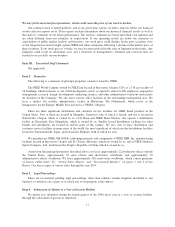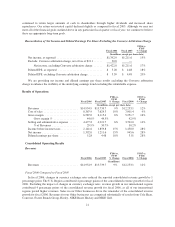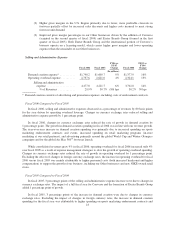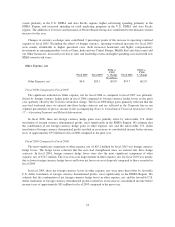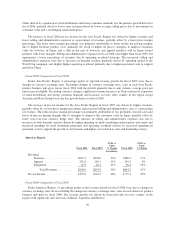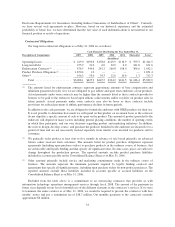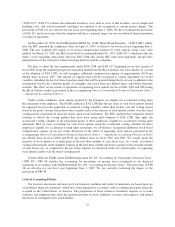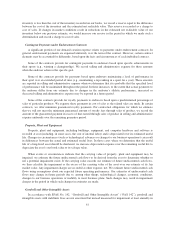Nike 2006 Annual Report Download - page 28
Download and view the complete annual report
Please find page 28 of the 2006 Nike annual report below. You can navigate through the pages in the report by either clicking on the pages listed below, or by using the keyword search tool below to find specific information within the annual report.
The discussion following includes disclosure of pre-tax income for our operating segments. We have
reported pre-tax income for each of our operating segments in accordance with Statement of Financial
Accounting Standard No. 131, “Disclosures about Segments of an Enterprise and Related Information.” As
discussed in Note 17 — Operating Segments and Related Information in the accompanying Notes to
Consolidated Financial Statements, certain corporate costs are not included in pre-tax income of our operating
segments.
U.S. Region
Fiscal 2006 Fiscal 2005
FY06 vs.
FY05
% Change Fiscal 2004
FY05 vs.
FY04
% Change
(In millions)
Revenues
Footwear ................... $3,832.2 $3,358.2 14% $3,070.4 9%
Apparel .................... 1,591.6 1,457.7 9% 1,433.5 2%
Equipment .................. 298.7 313.4 (5)% 277.9 13%
Total Revenues .......... $5,722.5 $5,129.3 12% $4,781.8 7%
Pre-tax Income .................. $1,244.5 $1,127.9 10% $1,007.3 12%
Fiscal 2006 Compared to Fiscal 2005
The increase in footwear revenues was due to a strong increase in unit sales, accounting for 12 percentage
points of the growth, and an increase in the average selling price per pair, accounting for 2 percentage points of
the growth. The strong unit increase was driven by increased consumer demand across a majority of the footwear
product categories, most significantly high demand for our Jordan branded and sport culture products. The higher
average selling price per pair was primarily due to increased consumer demand for products with a suggested
retail price over $100, driven by Jordan branded products as well as NIKE branded sport performance and sport
culture products.
The increase in U.S. apparel sales for fiscal 2006 was driven by increased unit sales in NIKE and Jordan
branded apparel, partially offset by sales declines in licensed apparel, primarily due to the expiration of our
license agreement with the NBA in the second quarter of fiscal 2005. The increases in NIKE branded apparel
were primarily due to increased sales of sport performance products.
For the U.S. Region, the increase in pre-tax income for fiscal 2006 as compared to 2005 was driven by
higher revenues and lower selling and administrative expenses as a percentage of revenues, more than offsetting
a lower gross margin percentage. The lower gross margin percentage was primarily the result of lower in-line net
pricing margins for footwear due to higher product costs, primarily the result of higher oil prices, and additional
costs incurred to meet strong footwear unit demand. Selling and administrative expenses were higher than fiscal
2005, but represented a lower percentage of revenues due to operating overhead leverage. The increase in selling
and administrative costs was due to increases in both demand creation and operating overhead. The increase in
demand creation was primarily driven by increased spending on sports marketing endorsements and events and
increased advertising, primarily due to the global campaigns discussed above. The increase in operating overhead
spending was driven by increased spending for new NIKE-owned retail stores, higher personnel costs and higher
travel and meeting expenses.
Fiscal 2005 Compared to Fiscal 2004
The increase in footwear revenue was due to a 5 percentage point increase in unit sales and a 4 percentage point
increase in the average price per pair. The increases in unit sales and the average price per pair were due to increased
consumer demand for sport performance products, especially those with a suggested retail price over $100.
27


